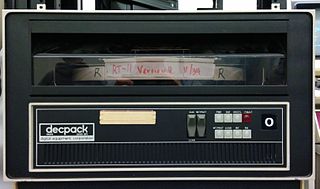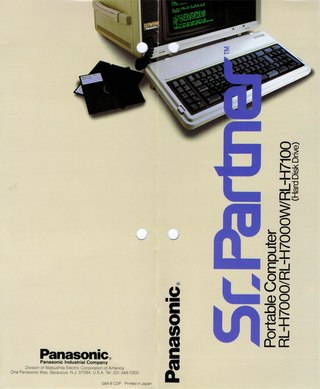Related Research Articles

A hard disk drive (HDD), hard disk, hard drive, or fixed disk is an electro-mechanical data storage device that stores and retrieves digital data using magnetic storage with one or more rigid rapidly rotating platters coated with magnetic material. The platters are paired with magnetic heads, usually arranged on a moving actuator arm, which read and write data to the platter surfaces. Data is accessed in a random-access manner, meaning that individual blocks of data can be stored and retrieved in any order. HDDs are a type of non-volatile storage, retaining stored data when powered off. Modern HDDs are typically in the form of a small rectangular box.

The IBM System/360 (S/360) is a family of mainframe computer systems announced by IBM on April 7, 1964, and delivered between 1965 and 1978. They were the first family of computers designed to cover both commercial and scientific applications and a complete range of applications from small to large. The design distinguished between architecture and implementation, allowing IBM to release a suite of compatible designs at different prices. All but the only partially compatible Model 44 and the most expensive systems use microcode to implement the instruction set, featuring 8-bit byte addressing and fixed point binary, fixed point decimal and hexadecimal floating-point calculations.

UNIVAC was a line of electronic digital stored-program computers starting with the products of the Eckert–Mauchly Computer Corporation. Later the name was applied to a division of the Remington Rand company and successor organizations.

The IBM 1440 computer was announced by IBM October 11, 1962. This member of the IBM 1400 series was described many years later as "essentially a lower-cost version of the 1401", and programs for the 1440 could easily be adapted to run on the IBM 1401.

A head crash is a hard-disk failure that occurs when a read–write head of a hard disk drive makes contact with its rotating platter, slashing its surface and permanently damaging its magnetic media. It is most often caused by a sudden severe motion of the disk, for example the jolt caused by dropping a laptop to the ground while it is operating or physically shocking a computer.
IBM manufactured magnetic disk storage devices from 1956 to 2003, when it sold its hard disk drive business to Hitachi. Both the hard disk drive (HDD) and floppy disk drive (FDD) were invented by IBM and as such IBM's employees were responsible for many of the innovations in these products and their technologies. The basic mechanical arrangement of hard disk drives has not changed since the IBM 1301. Disk drive performance and characteristics are measured by the same standards now as they were in the 1950s. Few products in history have enjoyed such spectacular declines in cost and physical size along with equally dramatic improvements in capacity and performance.
Pertec Computer Corporation (PCC), formerly Peripheral Equipment Corporation (PEC), was a computer company based in Chatsworth, California which originally designed and manufactured peripherals such as floppy drives, tape drives, instrumentation control and other hardware for computers.

Digital Equipment Corporation's RK05 is a disk drive whose removable disk pack can hold about 2.5 megabytes of data. Introduced 1972, it is similar to IBM's 1964-introduced 2310, and uses a disk pack similar to IBM's 2315 disk pack, although the latter only held 1 megabyte. An RK04 drive, which has half the capacity of an RK05, was also offered.

In 1953, IBM recognized the immediate application for what it termed a "Random Access File" having high capacity and rapid random access at a relatively low cost. After considering technologies such as wire matrices, rod arrays, drums, drum arrays, etc., the engineers at IBM's San Jose California laboratory invented the hard disk drive. The disk drive created a new level in the computer data hierarchy, then termed Random Access Storage but today known as secondary storage, less expensive and slower than main memory but faster and more expensive than tape drives.

Mohawk Data Sciences Corporation (MDS) was an early computer hardware company, started by former Univac engineers in 1964; by 1985 they were struggling to sell off part of their company.

The Sharp PC-7000 is a luggable portable computer released by Sharp Electronics in 1985. The PC-7000 was Sharp's second entry into the IBM PC-compatible portable computer market, their first being the PC-5000.

Blue Chip Electronics, Inc., later Blue Chip International, was an American computer company founded by John Rossi in 1982. Founded to develop peripherals for Commodore home computers, the company in 1986 began selling low-cost IBM PC compatibles.

The Dimension 68000 is a microcomputer introduced by the Micro Craft Corporation in 1983 that sought to emulate the Apple II, the IBM PC, and various CP/M-centric computers through a family of coprocessor expansion cards and emulation software. The Dimension 68000 can also run as a standalone computer based on the Motorola 68000 from which it gets its namesake. The computer is mostly the brainchild of Mike Carpenter, a former executive of a scientific instrument manufacturer who incorporated Micro Craft in Dallas, Texas, to develop the Dimension 68000. It had a market lifespan of three years and received mixed, mostly positive, reception from the technology press. Criticism was leveled at the $6,250 price tag for the computer with the full deck of coprocessor cards, as well as the extent of the emulation power of those cards.

The Senior Partner is an IBM PC-compatible portable computer that was introduced by the Panasonic Corporation in 1984. Weighing roughly 31 pounds (14 kg) in its base configuration, the computer came equipped with a cathode-ray tube display and a built-in thermal printer.
The Dot was a portable computer released by Computer Devices, Inc. in April 1983.
Areal Technology, Inc., was an American hard disk drive manufacturer active from 1987 to 1999. The company was the first to produce hard drives employing glass as the substrate for their platters, allowing for significantly higher data densities and greater shock resistance. Other hard drives manufacturers across the board soon followed suit with this approach. In 1993, Areal was sold to Tomen Electronics and Sanyo, who operated the company as a joint venture. Areal continued as a subsidiary until 1999.
Potter Instrument Company was a public American computer hardware company active from 1942 to the late 1970s and based in Long Island. It was founded by John Taft Potter (1911–1987), a prolific inventor of electronic instruments and magnetic computer storage devices. The company was the first to market a random-access mass storage device with interchangeable media in 1957.

Caelus Memories, Inc., was an American computer hardware company active from 1967 to 1985 and based in San Jose, California. The company focused on the manufacturing of magnetic data storage media, primarily disk packs. For a time, it was the second-largest manufacturer of disk packs in the world, designing units plug-compatible with IBM and Univac mainframes. In 1969, Caelus was acquired in whole by Electronic Memories & Magnetics; the latter was later acquired by Titan Systems in 1985.
References
- 1 2 3 4 5 6 7 8 Riley, Arthur A. (February 4, 1962). "Speedy Printer Can Fill Mile of Paper in 8 Hours". The Boston Globe: A-7 – via Newspapers.com.
- ↑ Staff writer (December 28, 1988). "George Fisher Barr". Valley News. West Lebanon, New Hampshire: 4 – via Newspapers.com.
- 1 2 Staff writer (November 16, 1968). "E. Ross Anderson, 72, Engineering Firm Chief". The Boston Globe: 21 – via Newspapers.com.
- 1 2 3 McQuade, Walter (August 1962). "The Deep Out-of-State Pocket". Fortune. LVXI (2). Time Inc.: 103–106, 184, 187–188 – via the Internet Archive.
- ↑ Staff writer (June 20, 1964). "Investor's Guide". Chicago Tribune: 2.7 – via Newspapers.com.
- 1 2 Staff writer (June 1952). "Computers—Analog". Electronics. 25 (6A). McGraw-Hill: D-29 – via the Internet Archive.
- ↑ Howe, Peter J.; Thomas C. Palmer Jr. (December 19, 1998). "AG files suit over handling of asbestos during demolition". The Boston Globe: B2 – via Newspapers.com.
- 1 2 Bell, Carl Irving (November 21, 1962). "Concord Corporation Pioneers in Many Space-Age Projects". The Concord Monitor: 1, 10 – via Newspapers.com.
- 1 2 Staff writer (June 1952). "High Speed Printer" (PDF). Radio-Electronic Engineering. Ziff-Davis: 23, 30 – via World Radio History.
- ↑ Staff writer (June 1952). "Trade Name Index". Electronics. 25 (6A). McGraw-Hill: D-131–D-146 – via the Internet Archive.
- 1 2 Spear, Roger E. (January 13, 1964). "Successful Investing". The Daily Register. Red Bank, New Jersey: 3 – via Newspapers.com.
- ↑ Staff writer (November 5, 1962). "Anelex Establishes New Division in City". The Minneapolis Star: 41 – via Newspapers.com.
- ↑ Staff writer (November 10, 1962). "Anelex Establishes New Division in City". Star-Tribune: 10 – via Newspapers.com.
- ↑ Staff writer (December 12, 1964). "Anelex Buys Newport Firm". The Concord Monitor: 7 – via Newspapers.com.
- ↑ Staff writer (December 12, 1964). "More Employment Seen for Newport". The Concord Monitor: 7 – via Newspapers.com.
- ↑ Staff writer (July 1963). "Anelex Acquires Franklin". The Office. 65 (7). Office Publications: 48 – via Google Books.
- ↑ Statland, Norman (December 1963). "Random Access Storage Devices: An Appraisal". Datamoation. 9 (12). Reed Business Information: 34–43 – via the Internet Archive.
- ↑ Staff writer (July 1964). "New Small Scale Memory System" (PDF). Computers and Automation. XIII (7). Berkeley Enterprises: 48 – via Bitsavers.
- ↑ Hess, Herman (1964). "A Comparison of the Characteristics of Modern Discs and Tapes". Disc File Applications: Reports Presented at the Nation's First Disc File Symposium (PDF). Informatics, Inc. pp. 60–70 – via Bitsavers.
- ↑ Staff writer (August 14, 1967). "Mohawk Data Plans Merger with Anelex". The Boston Globe: 26 – via Newspapers.com.
- ↑ Staff writer (October 18, 1967). "Stockholder Blessing on Anelex–Mohawk Data". The Boston Globe: 73 – via Newspapers.com.